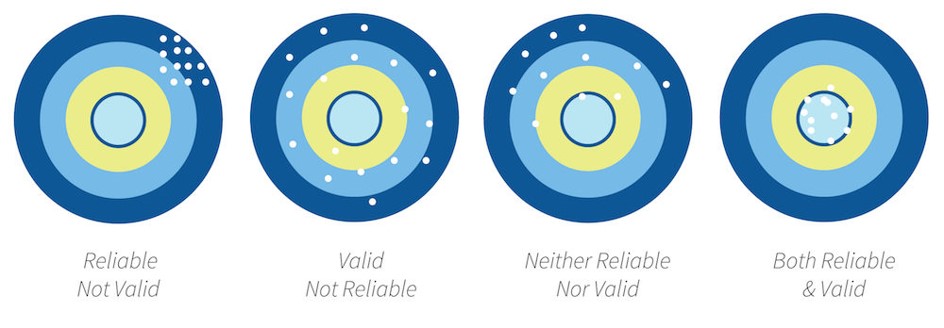2.5 Key Terms
This chapter will cover some basic key terms you should recall from PSYC 190 if you are in PSYC 290 or from earlier in the semester if you are in PSYC 790. These terms will come up repeatedly throughout the semester.
2.5.1 Study design terms
Some terms you should be familiar with:
Between-group/subject design: different people are in each condition; participants are only exposed to a single condition
Correlational research: a study in which causality cannot be claimed; correlation does not infer causation! It is, however, one of three necessary conditions to infer causality. It is a necessary but insufficient alone condition.
Cross-sectional research: also called non-experimental research; the IV is not manipulated and there is no random assignment. Furthermore, data is only collected at one time point (as opposed to longitudinal research)
Experimental research: the IV is manipulated and there is random assignment
Falsification: A key way we separate science from pseudo-science is that we attempt to falsify our hypotheses as opposed to try verify our hypotheses. Null hypothesis significance testing (NHST) is about falsifying the null hypothesis; we can never truly verify our alternative hypothesis.
Hypothesis: What we think the answer to our research question is (often our alternative hypothesis). The alternative and null hypotheses must be mutually exclusive (a result can’t satisfy both) and exhaustive (all possible results are specified)
Alternative hypothesis: Often that the IV had an effect on the DV; can be specified as a two-tailed (an effect) or one-tailed (greater/less than) hypothesis
Null hypothesis: Often the nill hypothesis in that the IV had no effect on the DV
Qualitative methods: Broadly, methods that focus on words and meaning (e.g., interviews)
Quantitative methods: Broadly, methods that focus on numbers and statistics (e.g., Likert scales)
Quasi-experimental research: the IV is manipulated but there is no random assignment
Randomization: participants are randomly assigned to conditions
Repeated-measures design: participants are repeatedly measured on the dependent variable, either across conditions or across time
Theory: A description of a behavior that makes predictions about future behaviors
Variation:
- Systematic: researcher something systematically error into the study, especially into one condition over another. For example, by randomly assigning participants into one of two conditions, we are introducing systematic variability between participants. However, it could be unintentional systematic variation; for example, perhaps we have two researchers collecting data and one is mean and the other is nice, and so participants respond differently depending on which researcher collects data from them.
- Unsystematic: random variation
Within-group/subject design: the same person is in all conditions
2.5.2 Variables
We tend to talk about two different types of variables in our studies:
- Independent variable (IV; also known as the predictor variable): this is the variable that is thought to be the cause of some effect. In experimental research, it is the variable that is manipulated.
- Dependent variable (DV; also known as the outcome variable): this is the variable that is thought to be affected by changes in the IV.
There are other types of variables we may be interested in:
- Confounding variable: a variable that affects or is related to both the independent and dependent variable
- Covariate: a variable that only affects or is only related to the dependent variable
2.5.3 Reliability and validity

Reliability: the consistency of a measure by time (test-retest reliability), across items (internal consistency) or across different researchers (inter-rater reliability)
Validity: the extent to which a test measures what it claims to measure
Construct validity: validity of inferences about the higher order constructs that represent sampling particulars. There are multiple types of construct validity; here are a few:
- Content validity: experts using their judgment that something measures what it is supposed to measure
- Convergent validity: correlations among two theoretically related constructs (or measurements) are strong and positive
- Divergent validity: correlations among two theoretically not-related constructs (or measurements) are zero/null
- Criterion validity: content on one test (predictor) correlates with performance on relevant criterion measures (outcome)
Statistical validity: validity of inferences about the correlation between treatment and outcome
Internal validity: validity about whether the observed relationship between A and B reflects a causal relationship between A and B
External validity: validity of inferences about whether the cause-effect relationship holds over variation in persons, places, treatment variables, and measurement variables
2.5.4 Other terms
If other terms come up in the course of the semester that you believe should belong in this key term website, include it in your weekly reflection so I can update this page!